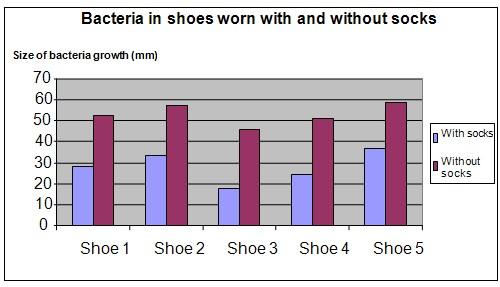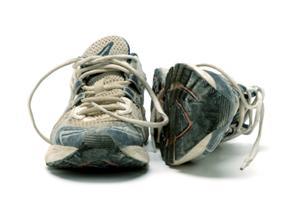| Complexity level: | 8 |
| Project cost ($): | 20 |
| Time required: | 1 hour to prepare, 1 hour for science project experiment |
| Material availability: | Easily found |
| Safety concerns: | The bacteria should be destroyed before the swabs are discarded. Pour some bleach into the petri dish to kill all the bacteria before disposing in the trash. |
Hypothesis
The amount of bacteria in the shoe will be higher if worn without socks.
Overview
Feet, bacteria and smell
Have you noticed that very often, when someone takes off his shoes, a strong stench is released? This strong smell is actually caused by the bacteria and the sweat on our feet. Each of our feet has over 250,000 sweat glands in them. When our feet get warm, they will start to sweat in order to cool down (when the sweat evaporates).
When we wear socks and shoes, the sweat in our feet is unable to escape anywhere. The moist, warm and dark environment in our shoes is perfect for bacteria to multiply and reproduce. The sweat produced by our feet actually does not have any smell r. The smell in fact arises, when the bacteria consumes our sweat for their metabolism. The fatty acid that is produced as a waste product causes the smell in our feet.
The reason some people have more smelly feet than others is because they sweat more. The number of sweat glands and the amount of sweat secreted will differ from person to person, depending on their physiology and body metabolism.
Scientific Terms
Materials
The materials required for this science project:
- 10 petri dishes prepared with agar
- 10 disinfected swabs
- 1 bottle of disinfected water
- 5 pairs of running shoes
- 5 pairs of cotton socks
- 5 participants
- 1 marker pen
Procedure
1. For this science fair project, the independent variable is whether the participant wears socks or not. The dependent variable is the rate of bacteria growth in the petri dish. This is determined by measuring the size of the bacteria colony using a ruler. The constants (control variables) are the type of shoes used, the type of socks used, the length of time the participants are made to wear the shoes, the room temperature and the amount of sunlight received.
2. The 10 petri dishes that are prepared with agar are stored in a refrigerator. The petri dishes are brought to room temperature before the start of the experiment by taking them out of the refrigerator and allowing them to attain the room temperature.
3. The experiment will require 5 participants. They are each given 1 pair of shoes and only one sock. The participants are required to wear the sock on their right foot only, before wearing their shoes. The shoe on the left foot is worn without socks.
4. For the next 3 hours, the 5 participants are made to walk, jog, play games and perform other physical activities that will cause their feet to sweat. After 3 hours the shoes are collected from the participants.
5. The sterilized swab is first made damp with the sterilized water. The swab is swathed around the inside of the shoe and then rubbed all over the surface of the petri dish. The cover is closed and the petri dish marked “With socks” for the right shoe and “Without socks” for the left shoe. The petri dish is kept in a cool shaded place for the bacteria to grow.
6. The diameter of the bacteria colony is measured after 5 days and recorded in the table below.

Results
The results show that all petri dishes with the sample taken from shoes worn without socks demonstrate a higher rate of bacteria growth.
|
Condition |
Bacteria growth in the sample from 5 shoes after 5 days (mm) |
||||
|
Shoe 1 |
Shoe 2 |
Shoe 3 |
Shoe 4 |
Shoe 5 |
|
|
With socks |
28 |
33 |
18 |
24 |
37 |
|
Without socks |
52 |
57 |
46 |
51 |
59 |
The chart below represents the results of our science experiment

Conclusion
The hypothesis that the amount of bacteria in shoes will be higher if they are worn without socks, is proven to be true.
The smell from our feet can be reduced by wearing cotton socks that are able to absorb sweat more effectively, and also by properly airing our shoes. The bacteria count can be lowered by frequently changing socks and washing our feet with antibacterial soap.
Also consider
This science project can be repeated by wearing socks made from different materials like cotton or polyester.
Modify the science project by using shoes made from different materials like leather, PVC, etc.
References
Why do feet stink? - http://health.howstuffworks.com/skin-care/information/anatomy/question5141.htm
What causes smelly feet? - http://www.brighthub.com/science/genetics/articles/48373.aspx

